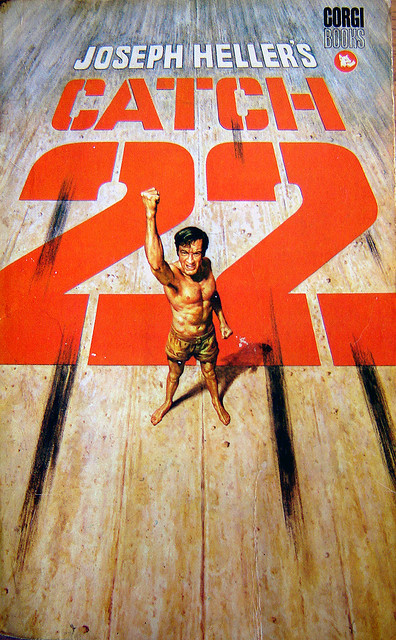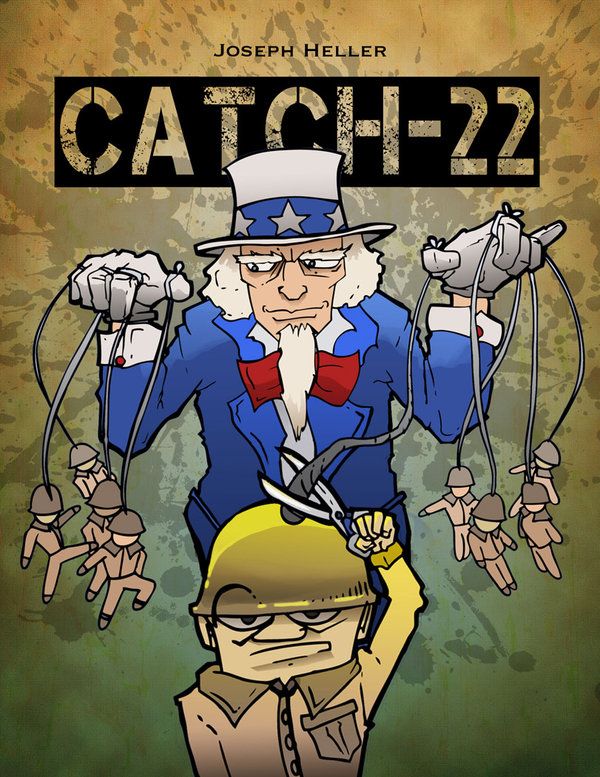“...[A]nything worth dying
for ... is certainly worth living for.”
 Catch-22 by Joseph Heller is set
during WWII on island of Pianosa (though the setting is of little importance). It
follows the story of a common soldier, Yossarian, and his friends. Yossarian
has lost many of his colleagues and friends to the war. His problems are
further perpetuated by Colonel Cathcar, who keeps raising the number of
missions the men had to fly to complete their service. No matter, how much
Yossarian longs to be sent home, he is trapped by a ‘Catch-22’. The term, coined
by Heller, refers to the paradoxical set of circumstances that the characters
are often faced with; especially, the idea that any soldier who is willing to
fly is insane and could be sent home if he asked for it, however, as soon as he
asks to be sent home he shows concern for his safety and is therefore of a
rational mind.
Catch-22 by Joseph Heller is set
during WWII on island of Pianosa (though the setting is of little importance). It
follows the story of a common soldier, Yossarian, and his friends. Yossarian
has lost many of his colleagues and friends to the war. His problems are
further perpetuated by Colonel Cathcar, who keeps raising the number of
missions the men had to fly to complete their service. No matter, how much
Yossarian longs to be sent home, he is trapped by a ‘Catch-22’. The term, coined
by Heller, refers to the paradoxical set of circumstances that the characters
are often faced with; especially, the idea that any soldier who is willing to
fly is insane and could be sent home if he asked for it, however, as soon as he
asks to be sent home he shows concern for his safety and is therefore of a
rational mind.
Heller’s satirical book is,
despite initial controversy, a defining novel of the 20th Century.
Despite it being set during WWII, the book concerns postmodernist ideas. The
book is still taught in schools and contains important critiques that can still
be applied to modern society. Any reader has to be prepared to face the absurdity
of Heller’s work. Personally, I did not enjoy the book. However, this is
because I prefer the structure and predictability of Victorian literature. But
I am glad that I read this book. I thought Heller presented very important
ideas and I agreed with many of his values; some of these ideas will be
explored later in this review.
The novel has become
representative of postmodernist literature by its subversion of form to
represent the zeitgeist of the time. The book uses an ‘anti-novel’ structure
and an ‘anti-hero’. The book rejects many of the traditional novel formats. The
book is not written in chronological order and does not follow the structure of
introduction, climax and conclusion. Instead the reader is introduced to
Yossarian in a hospital talking about events that will only occur at the end of
the book. Yossarian talks about the death of Snowden during a mission that isn’t
described until the second last chapter of the book. The novel also has an
ambiguous ending, living questions unanswered. Yossarian, the protagonist, is
not a ‘hero’. Yossarian has many faults and is quite insane – or at actually he
is quite sane in an insane world. Yossarian does not have the courage and
intengrity that heroes often display. The whole plot follows Yossarian’s plan
to escape, including the lies he creates to stay in a hospital where he can
escape his duties. These are two of the main ways that Heller changes the
format of books in order to represent the new values of the postmodern world.
Themes
Catch-22 deals with the changing
paradigms of the Post-World War II Western culture; to the point that is
follows, almost precisely, my own school education on after the bomb
literature. The book explores the loss of religious beliefs in a world that had
been capable of creating the abhorrent and horrific events of the war and the
nuclear bomb. The main character is an atheist, and believes that he’s seen too
much human suffering to believe that a God would allow so much torment. The chaplain,
himself, begins to question his own values. By the end of the novel, he has ‘tricked’
himself into sinning and doesn’t believe that God will actually harm him for
his deeds.
 The novel shows war to be absurd
and repugnant. The novel presents an unsentimental vision of war; not the
romantic and glorified versions views of war that were and are represented in
some media and supported by governments to inspire patriotism and nationalism.
Instead, the book shows that war is not moral and cannot be justified. Heller
explores the lives of the common soldier to show how they are not fighting for
their country or even against the enemy; instead, soldiers are fighting for the
pride of the bureaucracy. Soldiers are sent to fight in places that are not
strategic but will help get a colonel into a journal. The importance of ‘bomb
patterns’ become more important than the success of their missions. It shows
the superficiality of the individual battles and the ego of the commanders.
Yossarian, who sees the war clearly, wants to run away and understands that he
being there is not helping his country win the war. All characters are shown to
be absurd and have their own ‘insanity’ in order to show the dehumanisation of
the world. Some of this blame is also put on industry.
The novel shows war to be absurd
and repugnant. The novel presents an unsentimental vision of war; not the
romantic and glorified versions views of war that were and are represented in
some media and supported by governments to inspire patriotism and nationalism.
Instead, the book shows that war is not moral and cannot be justified. Heller
explores the lives of the common soldier to show how they are not fighting for
their country or even against the enemy; instead, soldiers are fighting for the
pride of the bureaucracy. Soldiers are sent to fight in places that are not
strategic but will help get a colonel into a journal. The importance of ‘bomb
patterns’ become more important than the success of their missions. It shows
the superficiality of the individual battles and the ego of the commanders.
Yossarian, who sees the war clearly, wants to run away and understands that he
being there is not helping his country win the war. All characters are shown to
be absurd and have their own ‘insanity’ in order to show the dehumanisation of
the world. Some of this blame is also put on industry.
The materialistic society and the
greed of businessmen for power and riches is demonstrated through Milo. Milo is
a caricature of a savvy businessman. In the capitalist context of the West, it
is the rich business owners who are ruling the country and controlling the
people. Through M&M Enterprise, Heller explores the power that industry has
on the individual. This becomes clear when the reader finds out the Milo is
supporting both sides of the war by providing information and supplies to both
sides. This is a very true comment on society. Although war profiteering has
become illegal in America, the USA still tends to gain from the sale of weapons
to other countries. Even in the Iraq conflicts and IS both sides have used
American manufactured weapons. America also profits from the sale of armaments
to many opposing small African countries. Milo’s power, however, can be applied
to even further than in the war context. Milo becomes a symbol of the ironic
paradox of the capitalist ‘freedom’. The west fought for individual freedom in
World War II. However, individuals are shown not be free and are instead
controlled by authority and by businessmen. Businesses sell the lifestyle and ideas
that will profit them and not the individual.
There are many more ideas, such
as the inevitability of death, but I feel those were the ones that stood out
for me. I am hesitant to recommend Catch-22 for teenagers but I know that the
ideas presented are quite important. This is a good book to study for school
even if it’s not the easiest of reads. It seems that nothing happens and yet,
by the end, Heller has introduced and critiques many values and beliefs. This is
definitely a text for more advanced readers and should be followed with a quick
research of themes in order to fully grasp the novel.

No comments:
Post a Comment